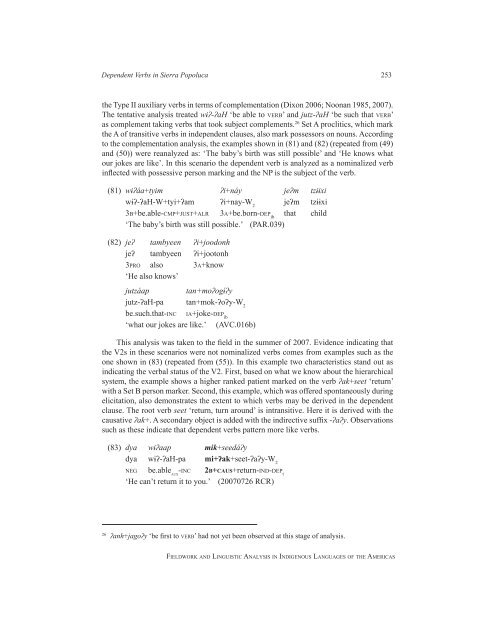Fieldwork and Linguistic Analysis in Indigenous ... - ScholarSpace
Fieldwork and Linguistic Analysis in Indigenous ... - ScholarSpace
Fieldwork and Linguistic Analysis in Indigenous ... - ScholarSpace
You also want an ePaper? Increase the reach of your titles
YUMPU automatically turns print PDFs into web optimized ePapers that Google loves.
Dependent Verbs <strong>in</strong> Sierra Popoluca 253<br />
the Type II auxiliary verbs <strong>in</strong> terms of complementation (Dixon 2006; Noonan 1985, 2007).<br />
The tentative analysis treated wɨʔ-ʔaH ‘be able to verb’ <strong>and</strong> jutz-ʔaH ‘be such that verb’<br />
as complement tak<strong>in</strong>g verbs that took subject complements. 26 Set A proclitics, which mark<br />
the A of transitive verbs <strong>in</strong> <strong>in</strong>dependent clauses, also mark possessors on nouns. Accord<strong>in</strong>g<br />
to the complementation analysis, the examples shown <strong>in</strong> (81) <strong>and</strong> (82) (repeated from (49)<br />
<strong>and</strong> (50)) were reanalyzed as: ‘The baby’s birth was still possible’ <strong>and</strong> ‘He knows what<br />
our jokes are like’. In this scenario the dependent verb is analyzed as a nom<strong>in</strong>alized verb<br />
<strong>in</strong>flected with possessive person mark<strong>in</strong>g <strong>and</strong> the NP is the subject of the verb.<br />
(81) wɨʔáa+tyim ʔi+náy jeʔm tzɨɨxi<br />
wɨʔ-ʔaH-W+tyi+ʔam ʔi+nay-W 2 jeʔm tzɨɨxi<br />
3b+be.able-cmP+Just+alr 3a+be.born-deP ib that child<br />
‘The baby’s birth was still possible.’ (PAR.039)<br />
(82) jeʔ tambyeen ʔi+joodonh<br />
jeʔ tambyeen ʔi+jootonh<br />
3Pro also 3a+know<br />
‘He also knows’<br />
jutzáap tan+moʔogɨ́ʔy<br />
jutz-ʔaH-pa tan+mok-ʔoʔy-W 2<br />
be.such.that-<strong>in</strong>c ia+joke-deP ib<br />
‘what our jokes are like.’ (AVC.016b)<br />
This analysis was taken to the field <strong>in</strong> the summer of 2007. Evidence <strong>in</strong>dicat<strong>in</strong>g that<br />
the V2s <strong>in</strong> these scenarios were not nom<strong>in</strong>alized verbs comes from examples such as the<br />
one shown <strong>in</strong> (83) (repeated from (55)). In this example two characteristics st<strong>and</strong> out as<br />
<strong>in</strong>dicat<strong>in</strong>g the verbal status of the V2. First, based on what we know about the hierarchical<br />
system, the example shows a higher ranked patient marked on the verb ʔak+seet ‘return’<br />
with a Set B person marker. Second, this example, which was offered spontaneously dur<strong>in</strong>g<br />
elicitation, also demonstrates the extent to which verbs may be derived <strong>in</strong> the dependent<br />
clause. The root verb seet ‘return, turn around’ is <strong>in</strong>transitive. Here it is derived with the<br />
causative ʔak+. A secondary object is added with the <strong>in</strong>directive suffix -ʔaʔy. Observations<br />
such as these <strong>in</strong>dicate that dependent verbs pattern more like verbs.<br />
(83) dya wɨʔaap mik+seedáʔy<br />
dya wɨʔ-ʔaH-pa mi+ʔak+seet-ʔaʔy-W 2<br />
neg be.able aux -<strong>in</strong>c 2B+CAUS+return-<strong>in</strong>d-deP t<br />
‘He can’t return it to you.’ (20070726 RCR)<br />
26 ʔanh+jagoʔy ‘be first to verb’ had not yet been observed at this stage of analysis.<br />
fieldwork <strong>and</strong> l<strong>in</strong>guistic analysis <strong>in</strong> <strong>in</strong>digenous languages of the americas

















